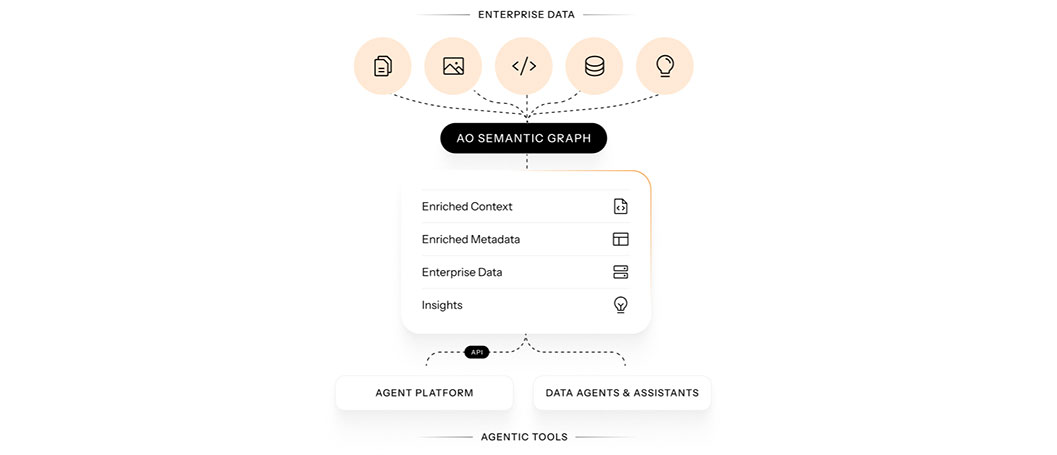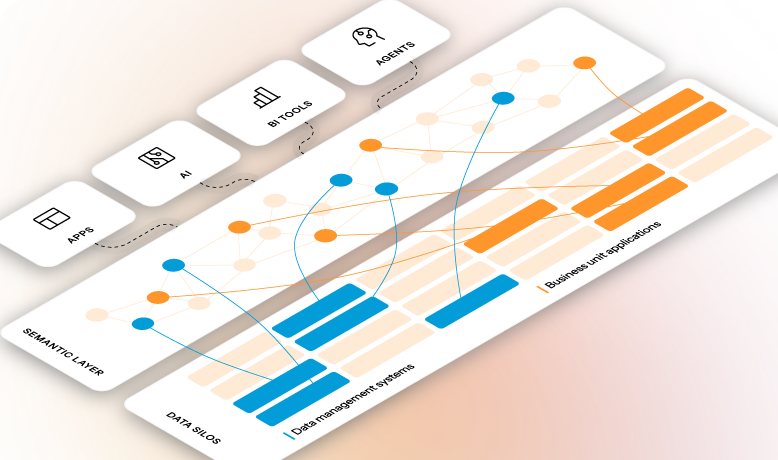
The Bottom Line: The Next Competitive Edge is Turning Data into Action with Gen AI

A New Era of Enterprise AI
Enterprise AI is entering a transformative era. Standalone models and static dashboards are giving way to autonomous, decision-making agents capable of acting on real-time insights.
But for these intelligent agents to succeed, they need far more than raw data. They require context, structure, and the ability to understand and interpret information to make smart decisions.
Key points:
- Enterprise AI is evolving from static dashboards to agentic AI—autonomous systems that sense, reason, and act on real-time signals.
- Deploying these agents requires more than access to data—it demands context, structure, and meaning.
- A semantic intelligence layer acts as a universal translator, connecting fragmented systems and enriching enterprise data for AI consumption
- The future is about chains of AI agents that analyze, decide, and execute driven by trusted data and governed systems.
The good news? Many of the necessary building blocks are emerging. The challenge is putting them together effectively.
The Rise of Agentic AI
Agentic AI—systems that can sense, reason, and act autonomously—is rapidly gaining traction across diverse enterprise use cases. Unlike traditional bots or rule-based automations, these intelligent agents dynamically adapt to evolving inputs and complex situations.
Consider some examples where agentic AI can deliver immediate real business value:
- Proactive churn mitigation
- Personalized outreach based on real-time customer signals
- Supply chain rerouting during unexpected disruptions
However, to achieve these outcomes, agents must deeply understand who a customer is, what they’ve done, and why they might be at risk, interested, or ready to act.
This requires connecting not just to data—but to semantics, business signals, and advanced models that transform raw inputs into actionable insights.
Semantic Intelligence: The Missing Layer
A growing number of enterprises are turning to semantic data layers to bridge the gap between their AI initiatives and fragmented data infrastructure.
Think of a semantic layer as a universal translator that connects data scattered across CRMs, support platforms, ERPs, engagement tools, etc. It enriches this data with business logic, taxonomies, and business-specific knowledge.
This empowers agents to:
- Query data in natural language (e.g., “Which customers are likely to churn in the next 30 days?”)
- Receive contextual, synthesized answers—not just raw database extracts
- Tap into pre-built models for churn prediction, sentiment analysis, or purchase propensity
Rather than individually training each agent on the intricacies of specific data systems, a semantic layer offers centralized intelligence that any agent can access.
Real-World Use Cases
Across industries, forward-looking companies are already layering agentic AI on top of semantic intelligence to unlock powerful new capabilities:
1. Proactive Churn Management
Agents analyze sentiment trends, support interactions, and purchasing behaviors to identify high-risk customers and automatically recommend tailored retention strategies.
2. Marketing Optimization
By modeling demographic and behavioral data, businesses can pinpoint the geographic regions likely to deliver the best ROI for marketing spend.
3. Airport & Retail Space Optimization
Airports and retail operators are studying foot traffic and passenger preferences to decide whether to allocate space to sit-down restaurants, kiosks, or grab-and-go options—maximizing both revenue and customer satisfaction.
4. Supplier & Logistics Planning
Manufacturers leverage predictive agents to identify the optimal supplier mix to boost fill rates and reduce supply chain disruptions.
These are just a few examples pointing to an undeniable trend: decision-making agents are emerging as critical enterprise tools—and they’re hungry for cross-domain, intelligent data.
What’s Next: From Insights to Interventions
We’re moving into a world where insights alone aren’t enough. AI agents must also determine what to do next—and then execute it.
The future lies in connecting multiple agents into intelligent workflows:
- A Data Agent gathers and synthesizes raw data (e.g., customers likely to churn).
- An Action Agent decides on the best intervention (e.g., offer a discount or schedule a personal call).
- A Delivery Agent executes the task (e.g., sends the offer or books the call).
All of this can happen provided the right data, governance, and logic are in place.
Final Takeaway
The next generation of enterprise AI isn’t just about generating insights—it’s about building systems that act on those insights autonomously and intelligently.
Organizations that invest today in semantic intelligence and agentic AI architectures will be the ones who transform raw data into genuine business outcomes.
App Orchid accelerates enterprise-AI, analytics, and decision intelligence—connecting data, context, and users for smarter, faster outcomes.
Related articles



The Best Path to
AI-Ready Data
Experience a future where data and employees interact seamlessly, with App Orchid.

